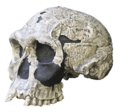Like contemporary Homo, H. habilis brain size generally varied from 500 to 900 cm3 (31–55 cu in). The body proportions of H. habilis are only known from...
52 KB (6,319 words) - 04:00, 25 November 2024
include Homo erectus and Homo neanderthalensis. The oldest member of the genus is Homo habilis, with records of just over 2 million years ago. Homo, together...
94 KB (8,016 words) - 13:38, 11 January 2025
Homo, though they both agreed that the remains could belong to habilis. KNM-ER 1470 was much larger than the Olduvai remains, so the terms H. habilis...
32 KB (3,908 words) - 16:05, 17 December 2024
between Stw 53 and H. habilis by Curnoe was that some of the tooth crowns of Stw 53 were larger than the average tooth crowns of H. habilis whereas other tooth...
14 KB (1,582 words) - 15:13, 8 January 2025
represents an otherwise undetected migration of small, Australopithecus or Homo habilis-grade archaic humans outside of Africa. This hominin was at first considered...
73 KB (7,609 words) - 12:34, 9 January 2025
Human evolution (redirect from Evolution of Homo sapiens)
Kenya. The earliest member of the genus Homo is Homo habilis which evolved around 2.8 million years ago. H. habilis is the first species for which we have...
264 KB (26,321 words) - 11:30, 9 January 2025
Human taxonomy (redirect from Homo sapiens sapiens)
species of Homo (alongside H. habilis and H. erectus) at about 2 million years ago, or alternatively as transitional between Australopithecus and Homo. Wood...
35 KB (5,163 words) - 16:27, 16 December 2024
australopithecines as well as earlier and more basal species of Homo, such as H. habilis. Among these features are their larger body mass, relatively long...
72 KB (9,279 words) - 19:29, 9 January 2025
appearance of genus Homo takes place around 2.8 million years ago with Homo habilis, followed by Homo erectus at around 1.8 million years ago, Homo neanderthalensis...
38 KB (5,040 words) - 04:29, 7 January 2025
Neanderthal (redirect from Homo sapiens neanderthalensis)
Neanderthals (/niˈændərˌtɑːl, neɪ-, -ˌθɑːl/ nee-AN-də(r)-TAHL, nay-, -THAHL; Homo neanderthalensis or H. sapiens neanderthalensis) are an extinct group of...
335 KB (36,348 words) - 23:55, 11 January 2025
Homo luzonensis, also known as Callao Man and locally called "Ubag" after a mythical caveman, is an extinct, possibly pygmy, species of archaic human from...
15 KB (1,683 words) - 19:37, 26 December 2024
Human (redirect from HomoSapiens)
specimen LD 350-1 from Ethiopia, and the earliest named species are Homo habilis and Homo rudolfensis which evolved by 2.3 million years ago. H. erectus (the...
264 KB (25,381 words) - 14:11, 11 January 2025
and fossils of Paranthropus boisei and Homo habilis, as does Bed II, 1.7 to 1.2 mya. H. habilis gave way to Homo erectus at about 1.6 mya, but P. boisei...
30 KB (3,710 words) - 18:56, 21 November 2024
The Soundtrack of Our Lives (redirect from Homo Habilis Blues)
Year Details 1996 Homo Habilis Blues Released: 1996 Label: Telegram Records Position: No. 23 (SWE) 2000 Gimme Five! Released: 21 June 2000 Label: Telegram...
17 KB (966 words) - 17:33, 2 January 2025
Early modern human (redirect from Anatomically modern Homo sapiens)
anatomically modern human (AMH), are terms used to distinguish Homo sapiens (sometimes Homo sapiens sapiens) that are anatomically consistent with the range...
115 KB (12,598 words) - 01:15, 10 January 2025
Denisovan (redirect from Homo Denisovan)
archaic humans. The third molar is outside the range of any Homo species except H. habilis and H. rudolfensis, and is more like those of australopithecines...
73 KB (7,485 words) - 08:07, 11 January 2025
Hominin 9, but when he described H. habilis a few years later, he unpopularly circumvented H. erectus and placed H. habilis as the direct ancestor of H. sapiens...
72 KB (8,062 words) - 20:23, 11 January 2025
very early from contemporaneous Homo. It is unclear whether they branched off at approximately the time of H. habilis, H. rudolfensis, and A. sediba,...
56 KB (6,280 words) - 14:26, 10 January 2025
Early expansions of hominins out of Africa (redirect from Dispersal of Homo erectus)
be considered Homo habilis, or a form of early Homo or late Australopithecus closely related to Homo habilis, or a very early form of Homo erectus. In any...
57 KB (6,191 words) - 08:35, 3 December 2024
Paleolithic (section Homo erectus)
Humankind gradually evolved from early members of the genus Homo—such as Homo habilis, who used simple stone tools—into anatomically modern humans as...
107 KB (11,395 words) - 16:00, 4 January 2025
paniscus Homo habilis Homo rudolfensis Homo ergaster Homo erectus Homo antecessor Homo heidelbergensis Homo naledi Homo neanderthalensis Homo denisova Homo sapiens...
24 KB (2,425 words) - 09:39, 19 December 2024
interpreted as either a distinct species, Homo rudolfensis, or alternatively as evidence of sexual dimorphism in Homo habilis. In 1967, Richard Leakey reported...
27 KB (3,109 words) - 04:34, 23 May 2024
However, in conjunction with dental evolution, it is expected that Homo habilis would display smaller teeth than those of the hominids before them. Furthermore...
19 KB (2,015 words) - 06:44, 31 October 2024
uncovering further evidence for australopithecines, as well as for Homo habilis and Homo erectus. The scientific community took 20 more years to widely accept...
48 KB (5,124 words) - 15:22, 8 January 2025
to have been invented by the later H. habilis, though this may have instead been produced by contemporary Homo. Like other australopithecines, A. garhi...
17 KB (2,043 words) - 01:52, 14 November 2023
Timeline of human evolution (section Homo)
the major events in the evolutionary lineage of the modern human species, Homo sapiens, throughout the history of life, beginning some 4 billion years ago...
88 KB (3,505 words) - 06:40, 7 January 2025
Australopithecine (section Relation to Homo)
extinct, close relatives of modern humans and, together with the extant genus Homo, comprise the human clade. Members of the human clade, i.e. the Hominini...
17 KB (1,550 words) - 12:26, 2 December 2024
Homo juluensis is an extinct species of archaic human from the Middle Pleistocene of China which encompasses Xujiayao, Xuchang Man, Penghu 1, and possibly...
6 KB (616 words) - 18:32, 8 January 2025
Homo heidelbergensis (also H. erectus heidelbergensis, H. sapiens heidelbergensis) is an extinct species or subspecies of archaic human which existed from...
66 KB (8,069 words) - 18:50, 2 January 2025
Piacenzian (section Origin of the genus Homo)
the genus Homo developed out of the ancestral genus Australopithecus. While the oldest known fossils unambiguously identified as Homo habilis date to just...
13 KB (1,354 words) - 15:15, 13 December 2024

























